
Q. What would you like to study using Akari?
I'm very interested in finding how galaxies have been formed and evolved in the universe.
The Hubble Space Telescope shows that star-formation activity was much more active in the past than that of the current universe.
Stars are believed to be the primary source of galaxies, but black holes are another energy source. This might sound a little odd, as not even light can escape from them. However, when something falls into a black hole, instead of going down all at once, it starts spinning very fast around the black hole, and releasing part of its gravitational energy as heat. We now know that many galaxies contain very massive black holes at their centers. Our galaxy also has a huge black hole that is about three million times as heavy as the Sun.

Such massive black holes and ordinary stars may appear to have nothing to do with each other, but recent studies have revealed that the mass ratio of stars to black holes in galaxies is almost constant. One can naively assume that there is no connection between the process of the birth of stars and black holes, but we are now finding that there may be a relationship between the two. How have stars and black holes been formed in galaxies? It's a big mystery.
The formation of stars and massive black holes is believed to occur in environments of dense gas and dust. It's not possible to observe such places with visible light, but Akari can peer through the gas and dust to reveal what's happening there. I'd like to study the evolution of galaxies that shine brightly because of star formation and very massive black holes, and find out what their true relationship is.
Q. What do you think Akari's next significant observation will be?
Akari's primary mission is to make an all-sky survey (mapping the universe) in the infrared. The first infrared sky survey was made by IRAS 20 years ago. Despite its short 10-month survey, its results affected almost all fields of astronomy significantly, and IRAS is regarded as one of the most successful astronomical satellites in history. However, as shown in Figure 4, its images are very unclear compared to those of Akari. With its much higher resolution, Akari is expected to bring astronomers more exciting discoveries.
The universe is still full of mysteries - we know so little about it. I wish Akari's all-sky survey to be successful, and hope to unveil new aspects of the universe.
| 1 2 3 4 |
